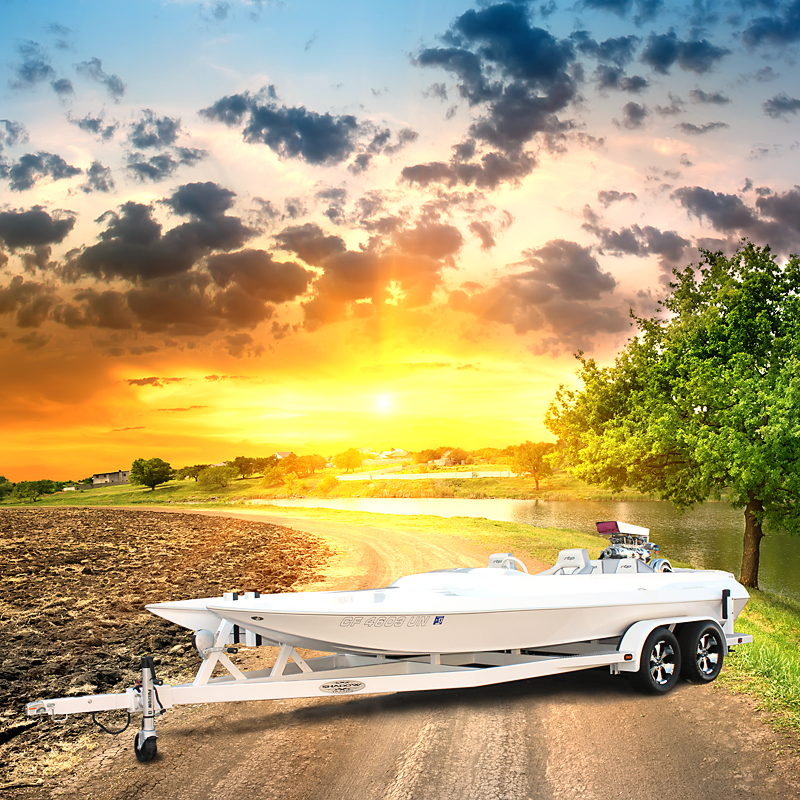Tips for Your Boat Trailer
- March 24, 2015
- Boat Trailers, Custom Boat Trailers, Custom Built Trailers
- Posted by shadgirl
- Comments Off on Tips for Your Boat Trailer
Boat trailers allow you to explore the fun hobby of boating. Having a trailer opens you up to an entire world of boating exploration. A convenient trailer allows for your boat to be taken with you almost anywhere you go. Considering all of the cost of bottom paint, blister repairs and slip fees – trailering provides a pleasing alternative. The following guidelines will help you experience towing in a safe and positive way.
Ready!
Don’t skip out on the trailer when you purchase a new boat. Remember, the new boat will be on the trailer for a large percentage of its life. The right trailer will help you transport your boat in an easy and safe manner. Ideal trailers will support your boat across the hull, with the combined weight of the hull, equipment and engine distributed evenly. Trailers that don’t evenly distribute weight in this manner are prone to causing hull damage. The trailer you purchase should have an advertised capacity of the combined weight of the motor, equipment and boat. Remember, trailer ratings indicate their maximum weight capacity. Having a boat trailer that exceeds the combined weight will extend the life of the trailer. Buying a trailer that’s one size larger than what you require means that you’ll be able to safely tow the occasional heavy load; however, a boat that’s too large and your boat may not fit properly and towing may be difficult.
Matching up the tow vehicle and the trailer is vital. The trailer must be able to be towed by the tow vehicle, including the boat, gear, fuel and water. Of course, there’s also the passengers and other equipment that’s towed within the vehicle. If you’ll be sticking to freshwater, painted trailers are ideal. However, powder coat or galvanized steel will offer enhanced long term service for salt water usage.
Get Set!
Before you begin any boating session, the trailer should be inspected. Additionally, there should be an annual inspection, which will help protect its value. Routine maintenance should also be performed. Consider developing a routine checklist that you run through before every trip to help keep you safe on the road. All bolts and nuts should be checked and verified that they’re tight. You should also inspect the coupler and tow ball and make sure they’re the same size. Thoroughly examine the safety chains and hitch. Rope, chains or turnbuckle should be used along with the winch to secure the bow. You may also need additional straps to secure the beam of the boat. The position of your trailer load is absolutely vital. Weight should be distributed evenly, from side to side and front to rear, with approximately 60 percent in the front. Don’t place too much weight on the back of the trailer, as this can lead to fish tailing due to reduced traction. Thoroughly examine the boat trailer’s wheel bearings and make sure that they are packed with fresh grease and completely airtight. Lights, shocks, springs and breaks should be checked on the trailer and the tow vehicle. Ensure that you have the right mirrors for the task as well, some stock rear view mirrors won’t provide you with the full picture of what’s going on.
Go!
When it comes to maneuvering the trailer and tow vehicle, practice certainly makes perfect. Before embarking on any new trip, take some time to practice backing up and turning on a level area, such as a clear parking lot. Once you’re on the road, try not to make sharp turns or any sudden moves when you’re trailering your boat; drive patiently and steer slowly. Leave plenty of space between you and any cars around you, which will help compensate for the weight of the boat should you have to stop suddenly. In these situations, you’ll need to apply firm and steady pressure to the brakes. Since the trailer will sharply cut any corners, you’ll need to turn wider than you normally would. If possible, have a passenger help you with backing down ramps and parking to avoid scrapes. Prepare your boat for launching away from the ramp, to leave the ramp open for other boaters. Check the boats drain plug prior to launching. Make sure the tow vehicle’s exhaust pipes stay dry when preparing to launch. When dealing with your average ramp, it’s ideal to back the trailer into the water until the front wheels are at water level. You may have to adjust this practice for flatter or steeper ramps. You’ll need to ensure that you use the parking brake and make use of tire chocks directly behind the wheels. This provides for an added safety measure that may just save your vehicle. Disconnect your winch hook and boy, then continue to launch with a small shove, or by backing the trailer up slightly. Drive away from the ramp to finish launching your boat.
Once you’re ready to load your boat back onto the trailer, reverse the launch procedure. Pay close attention to the various changes in wind direction, current, tide and velocity. Be aware of boating traffic in the area as well. Be careful not to submerge the trailer too deeply. Steer the boat to the trailer and then raise the motor. Before pulling the boat to the top of the ramp, secure the boat with the winch hook.
The information above is intended to be useful hints, not definitive instructions for maintaining a boat trailer. Consult the trailer’s owner’s manual for complete instructions and safety guidelines.


